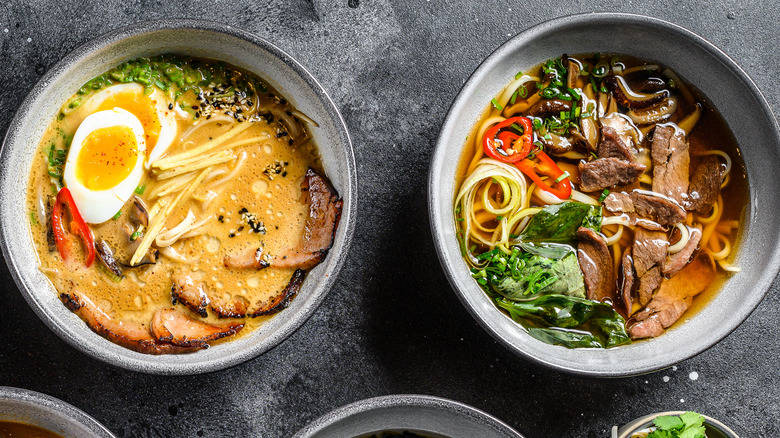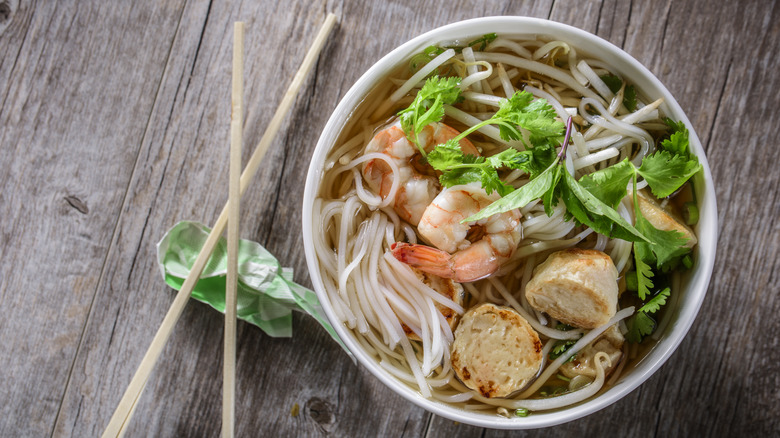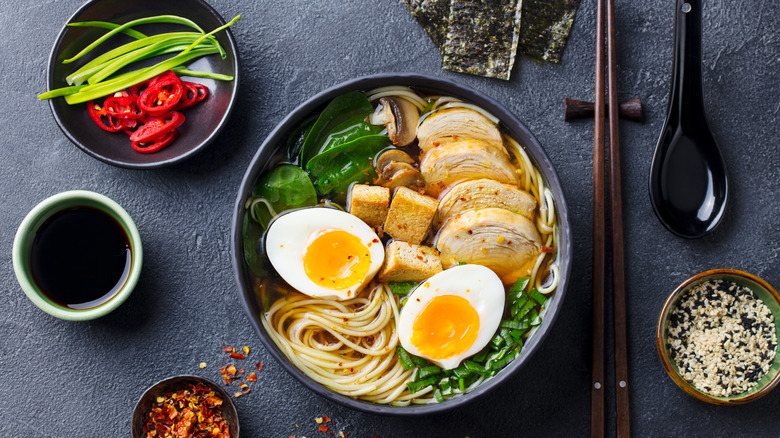The Key Differences Between Pho And Ramen
When it comes to iconic noodle soups, pho and ramen reign supreme in the culinary world. Hailing from different corners of the globe, these two dishes offer an exquisite journey of flavors, aromas, and textures that have captured the hearts and palates of food enthusiasts worldwide. But just because you enjoy one or both dishes doesn't mean you might be completely familiar with what differentiates them.
Apart from where each dish comes from, both have slightly different characteristics that make them truly unique. From the type of broth that is used to the toppings you'll find on each soup-like dish, pho and ramen certainly have their own defining components. In this exploration, we delve into the captivating contrasts between pho and ramen. Once you know what to look for and what you enjoy eating more, you can easily understand which dish to turn to or make at home when the craving strikes.
What is pho?
Pho's roots are deeply embedded in Vietnamese culture and history. While its exact origin is the subject of some debate, most historians agree that pho emerged in the northern regions of Vietnam, likely during the late 19th century. Its creation was influenced by various culinary traditions, including the Chinese and the French.
One popular theory suggests that pho is a Vietnamese adaptation of the French dish "pot-au-feu," a hearty beef stew. The French introduced beef to Vietnam during their colonial rule, and it is believed that local chefs began incorporating beef into their noodle soups, leading to the birth of pho. Pho's flavor profile is characterized by its elegant simplicity. The broth is clear and clean, with subtle hints of spices and a gentle sweetness. The focus is on balance, allowing the individual components to shine harmoniously.
Over time, pho evolved into a distinctly Vietnamese dish, with regional variations reflecting the country's diverse culinary landscape. Today, it stands as a symbol of Vietnamese culinary pride and ingenuity.
What is ramen?
Ramen's story begins in the late 19th century when Chinese immigrants brought their noodle-making techniques to Japan. The word "ramen" itself is derived from the Chinese term "lamian," which means hand-pulled noodles. Over time, ramen underwent a transformation, evolving into a uniquely Japanese dish with regional variations that showcase the country's culinary diversity.
One of the key moments in ramen's evolution was the introduction of kansui, which translates to "alkaline water," into the noodle-making process. This addition gave ramen noodles their distinct texture and allowed them to stand out from other types of noodles. The innovation quickly gained popularity, and ramen shops began to pop up across Japan.
Ramen's flavor profile is a symphony of bold and complex notes. Depending on the type of ramen, it can range from intensely salty (shio), savory and soy-forward (shoyu), hearty and robust (miso), to intensely creamy and porky (tonkotsu). The toppings and protein further enhance the depth and diversity of flavors.
Ramen noodles are more substantial
The heart and soul of pho lies in its thin, flat rice noodles, known as "bánh phở." These translucent, silky noodles have a delicate texture that absorbs the flavors of the broth while maintaining a gentle chewiness. They're traditionally hand-cut, resulting in varying thicknesses that add to the charm of pho.
Ramen, in contrast, features a wide array of noodle types, each with a distinct texture. The most common ramen noodles are made from wheat flour, water, and kansui (alkaline water). These noodles can range from thin and straight to thick and wavy, with varying degrees of firmness, offering a textural journey with every slurp.
Though pho and ramen noodles can range in thickness, an overall key difference between the noodles is their texture. Pho noodles tend to be cooked through more than ramen noodles making them softer and easier to chew. Ramen noodles are firmer with more bite to them making them ideal for easy slurping without the noodles breaking.
Pho has a transluscent broth
Pho's broth is characterized by its clarity and purity. It's made by simmering beef bones, charred onions, ginger, and a blend of spices, including coriander seed and fennel seed. The result is a light yet intensely aromatic broth, clear and infused with the essence of its components. It's typically seasoned with fish sauce and sugar, offering a subtle sweetness and umami depth.
Ramen broths, in contrast, span a spectrum of complexities. The four primary categories are shio (salt), shoyu (soy sauce), miso (fermented soybean paste), and tonkotsu (pork bone). These broths can simmer for hours or even days, infusing the soup with rich, bold flavors. Shio is known for its saltiness, shoyu for its savory umami, miso for its robustness, and tonkotsu for its creamy, porky richness.
Ultimately, ramen broth can often pack a more intense flavor than the more straightforward flavor profile of pho broth.
Pho typically centers around beef
While both pho and ramen can use the same proteins to top your decadent bowl of noodles, some are more common for one type than the other. For example, traditional pho offerings often revolve around beef, with thinly sliced rare beef, well-done flank, and beef meatballs being common choices. However, you can also find chicken (pho ga), seafood (pho hai san) and vegetarian (pho chay) variations. The protein takes a secondary role in the broth and noodles, adding depth and texture to the dish.
Ramen is a protein paradise. It features a variety of options, including chashu (braised pork belly or shoulder), ajitama (soft-boiled marinated egg), menma (fermented bamboo shoots) and kakuni (braised pork cubes). The choice of protein often defines the style of ramen, with tonkotsu ramen featuring pork and shoyu ramen typically featuring chicken or seafood.
So, ramen can more often include a variety of proteins while pho is typically geared more toward beef.
Ramen includes heartier toppings
The toppings for pho are typically fresh and minimal, allowing the simplicity of the broth to shine. A plate of fresh herbs, including Thai basil, cilantro, bean sprouts, lime wedges, and thinly sliced chili peppers, accompanies each bowl. These toppings add a burst of freshness and fragrance to each spoonful.
Ramen toppings are a playground of flavors and textures. Besides the protein, common ramen toppings include nori (seaweed), negi (green onions), menma (fermented bamboo shoots), narutomaki (fish cake), corn, mushrooms, and, of course, the aforementioned ajitama (soft-boiled egg). The variety of toppings can turn each bowl of ramen into a unique culinary adventure.
While pho and ramen share the common thread of being iconic noodle soups, their differences are what make them each so extraordinary. Both dishes offer a profound culinary journey that tantalizes the senses and captures the hearts of food enthusiasts worldwide. The choice between pho and ramen ultimately depends on your mood, your palate, and your willingness to explore the world, one delicious bowl at a time.






